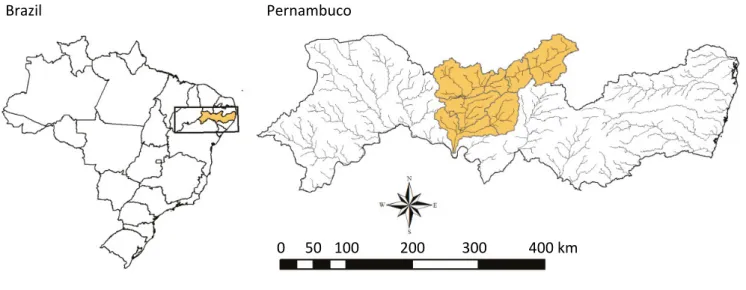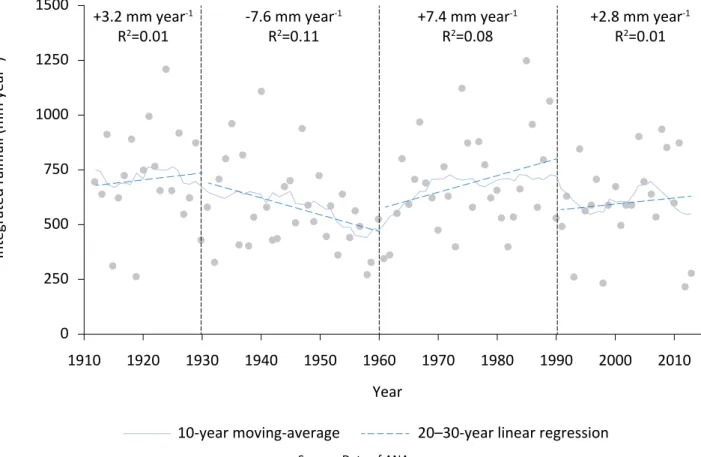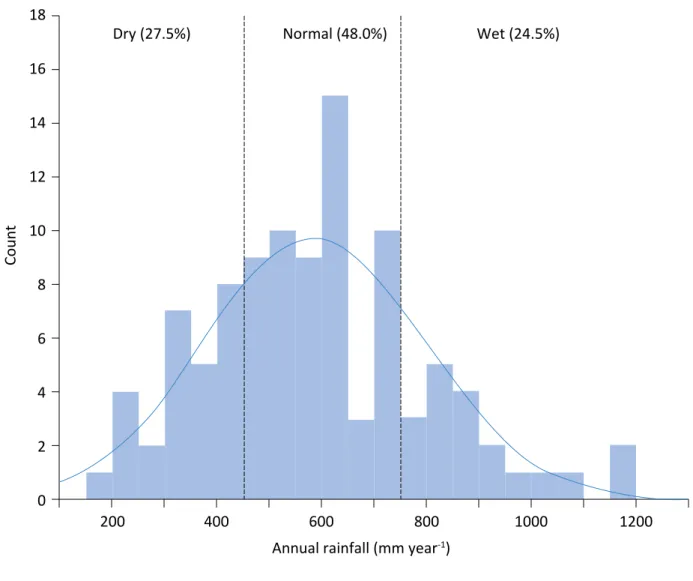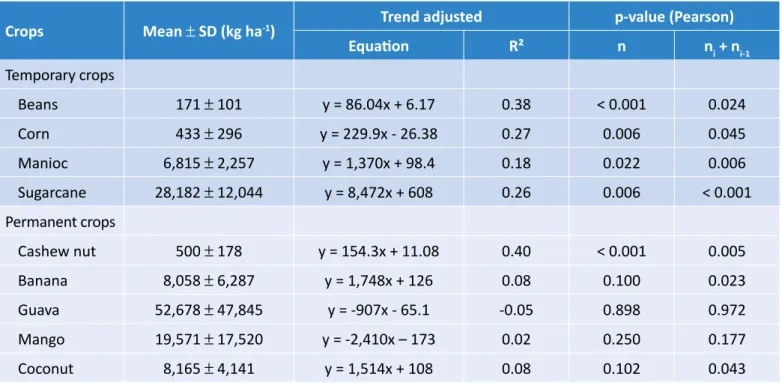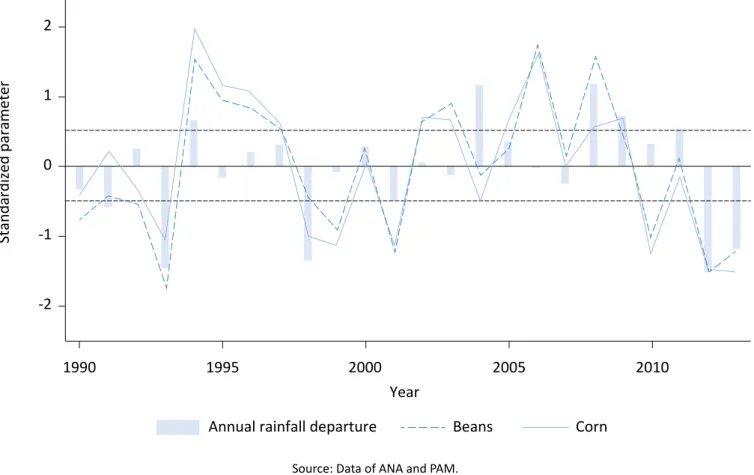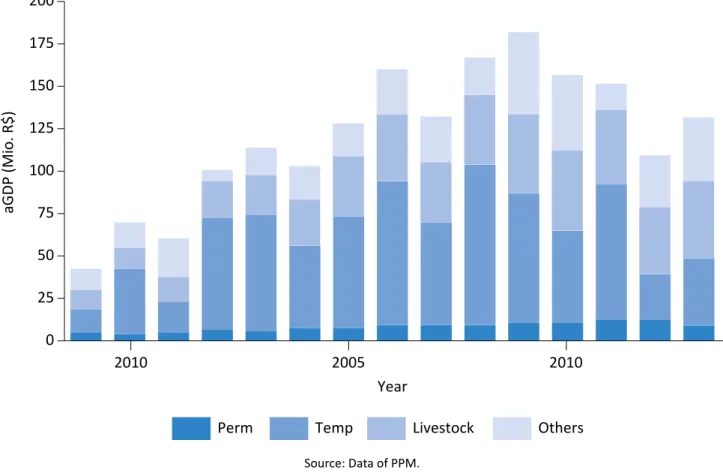Florian Selge
Ph.D., INNOVATE Project, Technical University of Berlin, Department of Water Quality Control– Berlin, Germany.
Heinrich Hagel
Ph.D., INNOVATE Project, University of Hohenheim, Computer
Applications and Business Management in Agriculture – Stuttgart, Germany.
Günter Gunkel
Assistant Professor, Vice-leader INNOVATE Project, Technical University of Berlin, Department of Water Quality Control, – Berlin, Germany.
Reiner Doluschitz
Professor, INNOVATE Project, University of Hohenheim, Computer Applications and Business
Management in Agriculture – Stuttgart, Germany.
Corresponding address:
Florian Selge – Straße des 17. Juni 135, 10623 – Berlin, Germany E-mail: florian.selge@tu-berlin.de
ABSTRACT
In the semi-arid region of Northeast Brazil, water resources are scarce and rainfall often has high temporal and spatial variability. Despite regional climate trends, no significant rainfall change could be detected by linear regressions in the Pajeú River watershed between 1912 and 2013. This study focused on the identification of regional impacts on agriculture in the form of crop yields, livestock, and animal products, through the annual rainfall variability. Yields of temporary crops were correlated to the annual rainfall departure, whereas permanent crops were less susceptible to droughts, but had a negative effect on the memory after the dry years. In the livestock sector, farmers reacted to the consequences of droughts and increased stocks of smaller animals with faster recovery rates, and also implemented apiculture. The results show a high vulnerability of agricultural production and regional income due to the low adaptation to local climate conditions. Hence, agricultural practices and water management should be further improved to fight against crucial economic depressions during droughts. Keywords: agricultural production; livestock; Pajéu River watershed; rainfall;
water scarcity.
RESUMO
A região semiárida do Nordeste do Brasil apresenta escassez de recursos hídricos e grande variação temporal e espacial da precipitação. Entretanto, apesar da tendência climática regional, não foi detectada variação significativa de precipitações na bacia hidrográfica do Rio Pajeú entre 1912 e 2013. Este estudo teve como foco a identificação de impactos regionais na produção agropecuária provocados pela variação anual da precipitação. A produção de lavouras temporárias apresentou forte relação com a precipitação anual. A produção de lavouras permanentes apresentou um efeito negativo após anos secos. Os criadores de animais se adaptaram aos efeitos da seca por meio do aumento da criação de animais de menor porte e da implementação da apicultura. Os resultados demonstraram alta vulnerabilidade da produção em razão do baixo grau de adaptação às condições climáticas. As práticas agrícolas e o manejo da água devem ser melhorados no intuito de combater os efeitos econômicos negativos da seca.
Palavras-chave: agricultura; pecuária; bacia hidrográfica do Rio Pajeú; chuva;
escassez de água.
DEPENDENCY OF SMALLHOLDER AGRICULTURE IN THE
SEMI-ARID NORTHEASTERN REGION OF BRAZIL
VARIAÇÃO DA PRECIPITAÇÃO ANUAL E A DEPENDÊNCIA ECONÔMICA DE PEQUENOS AGRICULTORES NO SEMIÁRIDO DO NORDESTE DO BRASIL
INTRODUCTION
Semi-arid regions are characterized by low annualrain-fall and suffer under severe droughts which occur rath-er frequently and whrath-ere watrath-er is really scarce (MON-TENEGRO & RAGAB, 2012). The high climate variability and extreme weather conditions enhance the vulner-ability of natural resources, threatening world popu-lations with an increasing trend of decreasing water availability (GUTIÉRREZ et al., 2014).
Societies, especially in semi-arid and developing re-gions, are specifically vulnerable to limitation of water resources and therefore, to changes of climate condi-tions. In addition, a dense population depending on few short-term options to earn their livelihood increas-es the anthropogenic princreas-essure on water availability (KROL & BRONSTERT, 2007; SIMÕES et al., 2010; MON-TENEGRO & RAGAB, 2012).
Although climate conditions are harsh in the semi-ar-id northeastern region of Brazil, agriculture has an important role for the local economy and society. In Brazil, family farming accounts for about 70% of the food consumed throughout the country (SIETZ et al., 2006; BURNEY et al., 2014). Given that water storage in soils as ground water or interflow water is limited in this region due to wide distributed crystalline rock formations and shallow soils, water availability is main-ly provided by spatial and temporal distributed annu-al rainfannu-all. However, other measures of water storage such as subsurface dams, small reservoirs, and cisterns are widespread in the region (CIRILO, 2008).
Traditional agriculture consists of extensive livestock breeding and (partly irrigated) cultivation of subsis-tence crops along the river margins or in the form of recession agriculture on the borders of temporary res-ervoirs (ANTONINO et al., 2005; SIETZ et al., 2006). Fur-thermore, for life quality maintenance, agricultural ex-pansion into less favorable areas and livestock grazing in natural areas are a common practice. This livelihood increased the pressure on natural resources and led to overgrazing, loss of natural vegetation, soil erosion, and landscape degradation with decline of crop yields (LEAL et al., 2005; SIETZ et al., 2006). More recently, large irrigation projects are developed along the peren-nial São Francisco river and around larger reservoirs. The strong negative economical and social impacts were recently observed in the most severe drought conditions since several decades from 2010 until 2013 in entire Brazil, but extremely in the semi-arid north-eastern region of Brazil (GUTIÉRREZ et al., 2014). Es-pecially in a scenario of global warming and changing rainfall patterns, agricultural production in semi-arid regions is at high risk (TONI & HOLANDA, 2008). As cli-mate variability and future changes affect especially non-irrigated agriculture, small subsistence farmers highly depend on water availability and are prone to economic depression during the years of drought, or else the death of their livestock due to thirst (KROL et al., 2006; LINDOSO et al., 2014). Due to the severi-ty of the problem, a profound analysis of the local im-pact of rainfall on agricultural production and the liveli-hood of the subsistence farmers should be carried out and the results used for other semi-arid regions.
MATERIALS AND METHODS
The study is conducted for the watershed of the Pajeú River in the semi-arid region of northeastern Brazil. It is the largest watershed in Pernambuco state and is locat-ed between 7°16’20” S to 8° 56’01” S and 36°59’00” W to 38°57’45” W. Its northern boundaries are identical to the state borders of Paraíba and Ceará, and it be-longs to the lower-central watershed of the São Fran-cisco river (Figure 1).
The hydrological basin of the Pajéu River with 22 mu-nicipalities covers an area of 16,686 km², about 2.4% of the total Caatinga biome or 17% of the state territory.
The watershed has a mean altitude between 300 and 500 m above sea level, whereas mountain ranges in the north reach up to 1,100 m above sea level.
This region is part of the drought polygon and is characterized by annual mean temperatures above 20 °C, annual rainfall less than 1,000 mm year-1, and high evaporation rates ranging between 1,500 and 2,500 mm year-1 (SAMPAIO, 1995). Most of the annual rainfall occurs from January to May; the rest of the year remains dry and receives only little amounts of rainfall. Frequently occurring one
year droughts are strongly related to the South-ern Oscillation phenomenon El Niño (RODRIGUES & MCPHADEN, 2014), but reasons for multi-year droughts are not yet well understood.
The region is characterized mainly by the Caatinga bi-ome – a deciduous xeric shrubby region typically on relatively shallow soils (SAMPAIO, 1995). In the study area, three soil types – luvisolic, regosolic, and areno-sol, cover more than 50% of the watershed with low water retention capacities. Groundwater is limited to areas of the sedimentary basin, but often tends to be saline (VOERKELIUS et al., 2003; CIRILO, 2008).
This integrated study is based on data from publicly available data sources in Brazil. Historical rainfall data were obtained from the National Water Agency of Bra-zil (ANA, 2014) for six active weather stations located along the Pajeú River course. Data resolution is carried out on a daily basis, but partly with large gaps of data records. Daily data were screened for false data, and corrected by linear interpolation of surrounding data, depending on the availability.
For this study, the data at the municipality level re-garding land use and demographic development were collected for all municipalities of the Pajeú River wa-tershed from the Brazilian Institute of Geography and
Statistics (IBGE, 2014). In addition, the IBGE offers historical data about annual agricultural and livestock production with the datasets Produção Agrícola Mu-nicipal (PAM, 2014) for the period from 1990 to 2013 and Produção da Pecuária Municipal (PPM, 2014) from 1973 to 2013.
Daily rainfall data were summarized to the annual totals of the respective stations and standardized as per the annual rainfall departure, with the fol-lowing Equation:
(1) where is the annual rainfall departure, is the an-nual total for station i, and year j, is the anan-nual mean rainfall at station i averaged over the study period, and is the standard deviation of the annual totals. The new time series are characterized by a mean equal to 0 and a variance equal to 1. The regionally integrat-ed rainfall departure is calculatintegrat-ed as the means for all stations. The annual rainfall departure is defined into three categories: z < -0.5 refer to dry years; z > 0.5 refer to wet years; -0.5 < z < 0.5 define normal years; where the z-score indicates how many standard deviations
400 km
Brazil Pernambuco
0 50 100 200 300
Source: Data of ANA, map created by authors.
Figure 1 – Brazil and the study area in Pernambuco state located in the semi-arid region of northeastern Brazil (Pernambuco state is marked on the Brazilian map), as well as the Pajeú River watershed (marked on the Pernambuco map).
an element is from the mean; analog to Kutiel et al. (2014). For the categorization of the entire domain, the integrated standardized rainfall departure is calculated as mean across all stations.
Linear regression models are used for trend removing of analyzed time series and correlation of crop yields with annual rainfall departure and agricultural gross domestic product (aGDP) according to Equation 2:
(2) where is the standardized crop yield for crop i and, year j or the annual aGDP, a and b are the regression fac-tors for slope and intercept and is the residual error for crop i and, year j. The coefficient of determination (R2) larger than 0.75 describes a strong relationship, and a coefficient below 0.25 describes a weak relationship.
RESULTS
In the semi-arid area of northeastern Brazil, rainfall has a high spatial and temporal variability. In the Pajeú River watershed, more than 90% of the total rainfall occurs mostly in the rainy season from January until May, while the rest of the year is dry. The temperature is characterized by small annual amplitude between 23.3 °C and 27.9 °C, but relatively large daily
fluctua-tions between 20.0 °C and 33.7 °C as monthly means and all-the-year high evaporation rates.
Over the past century between 1912 and 2013, no sig-nificant trend of rainfall could be detected in the wa-tershed by linear regression analysis (Figure 2). How-ever, 20–30-year periods of linear regressions show variable but non-significant tendencies. Particularly, +3.2 mm year-1 R2=0.01 -7.6 mm year -1 R2=0.11 +7.4 mm year -1 R2=0.08 +2.8 mm year -1 R2=0.01
Integrated rainfall (mm year
-1 ) 1500 1250 1000 750 500 250 0 Year 1910 1920 1930 1940 1950 1960 1970 1980 1990 2000 2010
10-year moving-average 20–30-year linear regression Source: Data of ANA.
Figure 2 – Annual integrated rainfall (dots) in the Pajeú River watershed with 10-year moving-average (red line) from 1911 until 2013. Solid lines (black) represent linear regressions for 20–30-year periods with embodied annual slopes and R2. For the
the severe long drought period in the 1950s is strongly affecting regressions between 1930 and 1990. In con-trast, rainfall is more expressed by high annual variabil-ity between 300 mm and 1,500 mm with a mean of 585 mm year-1 at the stations within the Pajeú River watershed (Figure 3).
Within the period from 1912 to 2013, 9 severe droughts with z < -1.0 or less than 305 mm year-1 occurred. The frequency of severe or multi-year droughts is irreg-ularly distributed. In the period of 30 years (from 1930 until 1959), 16 years were classified as dry (z < -0.5), including 2 severe drought years; however, from 1960
until 1989, 4 years were dry, including 1 severe drought year. From 1990 to 2013, 5 dry years including 4 se-vere drought years were registered. But, the longest time period between 2 dry years was a maximum of 10 years with an average occurrence of every 3.4 years, whereas the time period between severe droughts was between 2 and 31 years with an average occurrence of every 12.9 years.
Agricultural production in the Caatinga is widely prac-ticed in a land tenure system. In the Pajeú River wa-tershed, the average farm size varied between 3.3 and 6.0 ha with an area-weighted mean of 4.9 ± 1.2 ha
Dry (27.5%) Normal (48.0%) Wet (24.5%)
Count 18 16 14 12 10 8 6 4 2 0
Annual rainfall (mm year-1)
200 400 600 800 1000 1200
Source: Data of ANA.
Figure 3 – Histogram of regional integrated annual rainfall in the Pajeú River watershed for the period 1912 to 2013; with a normal distribution around the mean of 585 mm year-1.
farm-1, but landownership is unevenly distributed. For easier water access and all-the-year water supply, most farms are allocated along a riverbed or close to larger reservoirs.
Crop production in the Pajeú River watershed is dom-inated by typical temporary subsistence crops, most-ly beans, corn, and tapioca, which cover a cumulative area of 173,067 ha (average from 1990 to 2012) rep-resenting 97% of the total temporary agricultural land use. The main permanent crops in the total planted area (8,083 ha, average from 1990 to 2012) for the entire Pajeú River watershed are cashew nut (57%), banana (16%), guava (12%), mango (5%), and coco-nut (4%), with banana and cocococo-nut recently becoming more important.
Crop yields depend on various factors: the main ones are water availability, temperature, solar radiation, soil characteristics, nutrients, fertilization, and irrigation practice, as well as pest control among others.
The calculated crop yields, by division of harvested weight through planted area, show a strong variability.
For example, corn as temporary crop varies between 0 and almost 1,000 kg ha-1. These strong variations of crop yields suggest varying management practices, and that other environmental conditions besides rainfall may play an important role within the study area. The trend-adjusted time series of crop yields, especial-ly of major temporary crops show a linked pattern to annual rainfall (Figure 4). Correlating annual crop yields with the annual rainfall departure shows the depen-dency of temporary crops on annual rainfall (Table 1). In contrast, the maximum length of consecutive dry days do not show any influence on crop yields in the study region.
Permanent crop yields are less significant correlated to annual rainfall departure, but including the previ-ous year annual rainfall departure by adding the an-nual rainfall departure of the respective two years (ni + ni-1), correlations become more significant for some permanent crops (Table 1). However, the cash crop cashew nut is highly correlated to the actual annual rainfall (p < 0.001), which covers 57% of the area for
Table 1 – Average crop yields with standard deviation and trend adjusted linear regression
equation in relationship to the annual rainfall departure. Pearson coefficients presenting correlations between crop yield and annual rainfall departure of the same year (n) and included weighted previous year (ni + ni-1).
Crops Mean ± SD (kg ha-1) Trend adjusted p-value (Pearson)
Equation R² n ni + ni-1 Temporary crops Beans 171 ± 101 y = 86.04x + 6.17 0.38 < 0.001 0.024 Corn 433 ± 296 y = 229.9x - 26.38 0.27 0.006 0.045 Manioc 6,815 ± 2,257 y = 1,370x + 98.4 0.18 0.022 0.006 Sugarcane 28,182 ± 12,044 y = 8,472x + 608 0.26 0.006 < 0.001 Permanent crops Cashew nut 500 ± 178 y = 154.3x + 11.08 0.40 < 0.001 0.005 Banana 8,058 ± 6,287 y = 1,748x + 126 0.08 0.100 0.023 Guava 52,678 ± 47,845 y = -907x - 65.1 -0.05 0.898 0.972 Mango 19,571 ± 17,520 y = -2,410x – 173 0.02 0.250 0.177 Coconut 8,165 ± 4,141 y = 1,514x + 108 0.08 0.102 0.043
permanent crops and has a major contribution to in-come production.
Livestock in the region is dominated by chicken (62%), goat (18%), cattle (9%), and sheep (6%), which cover summarized 95% of livestock in this region with in-creasing trends of stocks. In 1993, a sharp decrease in number of animals occurred due to the severe drought. More than 55% of the cattle and pig stock died because of water and food scarcity, whereas chicken and goats had a higher survival rate.
Recovery of stocks, especially for larger animals such as cattle and horses, needs several years. In contrast, the chicken stock was recovered within one year after the drought in 1993. Since this drought, apiculture was introduced with an increase of about 11% and pro-duction of quail eggs started in the region. In addition, chicken farming was extended and goat and sheep farming increased slightly, while pork production cur-rently plays a minor role.
Animal husbandry is also undertaken for products derived from animals. Here, milk and eggs are the main products for the region. From 1974 until 2012, the production of milk and eggs increased by 1.8 and 3.8%, respectively. In the drought of 1993, the amount of milked cows declined to 60% of the previous year’s stock; as also shown for Bahia by Burney et al. (2014). Not only did the total number of milk cows decline drastically but the average daily milk production per cow also decreased from 1.9 to 0.6 L. Although the number of milked cows recovered relatively fast with-in a few years, the average yield recovered more slow-ly (Figure 5).
The aGDP of the Pajeú River watershed varied on both temporal and spatial scales for the period 1999 to 2013. The aGDP shows a significant trend of a yearly growth rate of 8.8% for the entire watershed, but due to the severe multiyear drought from 2010 to 2013, the aGDP declined about 40% from 182.2 Mio R$ in 2009 to 109.8 Mio R$ in 2012 (Figure 6). The
par-Corn Standardized parameter 2 1 0 -1 -2 Year 1990 1995 2000 2005 2010
Annual rainfall departure Beans Source: Data of ANA and PAM.
10 8 6 4 2 0 Quantity (in 10 3 ) Year
Mean yield (L cow
-1 day -1) 60 50 40 30 20 10 0 1970 1980 1990 2000 2010
Cows milked Milk (103 L) Mean yield
tial contribution of the selected agricultural sectors temporary and permanent crops as well as livestock is temporally relative, and account for 45.6, 7.0, and 26.1% of the total aGDP. However, during the drought, the temporary crop income had had for the most part decreased significantly.
As presented in the aGDP, low annual rainfalls favored reduced crop yields, led to death of livestock and decrease in animal produce. Due to these facts, the entire watershed shows in the period between 1999 and 2012 an existing relationship and a significant cor-relation between the aGDP and the annual rainfall. As a result, the local economy was under stress during these periods and had a major negative impact on the livelihood of the people.
Although permanent crop yields and milk yield are affected by the previous year’s conditions, the
annu-al rainfannu-all departure of the same year has the high-est correlation with the trend-adjusted aGDP of the entire watershed (Pearson: p = 0.01). According to the modeled relationship between aGDP and annu-al rainfannu-all departure by linear regression, a drought year with an annual rainfall departure of -1.5 reduces the aGDP by 33% (41 Mio R$). A wet year with an annual rainfall departure of 1.5 increases the aGDP by approximately 34 Mio R$ or 28%. This reflects the strength of drought years for the local agricultur-al economy, as losses by dry years cannot be com-pensated by wet years. In Table 2, the sensitivity of agricultural production to annual rainfall variability is expressed by the slope of the linear regression function. The downstream area shows on one hand, a lower dependency on annual rainfall with more sta-ble income generation, but generates on the other hand a lower aGDP in wet years than the upstream Source: Data of PPM.
Figure 5 – Development of milk production in the Pajeú River watershed with number of cows, milk (in 1000 L) and the mean milk yield in L per cow and per day.
region. The residual distances between predicted and observed aGDP are mainly explained by livestock practices. In the upstream region, the number of milk
cows (p = 0.03) and pigs (p = 0.04) and downstream milk production per cow (p = 0.03) describe the ma-jor variance of the model.
DISCUSSION
Global climate models mostly agree in the predictionof higher rainfall variability and longer droughts in semi-arid regions (IPCC, 2014; BURNEY et al., 2014). However, regional climate models show changes in precipitation trends for northeast Brazil (KROL & BRONSTERT, 2007; MARENGO et al., 2009). Several au-thors state that the semi-arid region is the most vulner-able area of Brazil regarding climate change impacts, amplified by the high population density, reduced pro-ductivity, livestock deaths, and out-migration of labor (SIMÕES et al., 2010; LOBELL et al., 2011).
Da Silva (2004) performed a trend analysis of climate parameters for the northeastern region and identified an increasing trend toward climate variability, whereas the two considered stations within the Pajeú River wa-tershed showed no significant trends, which is consis-tent with the findings of this study. This may be due to the mitigation measures of large reservoirs, rainwater harvesting such as small reservoirs, subsurface dams, cisterns, and increased areas of irrigation agriculture in the region having an effect on local climate condi-tions (DA SILVA, 2004). Still, vegetation change toward strongly reduced ground covering can reverse this ef-fect and negatively influence local climate (OYAMA & NOBRE, 2004; BURNEY et al., 2014).
Although rainfall and related water availability in the studied watershed does not underlie any observ-able trend, stress on water resources is increasing in drought periods due to population growth and increas-ing land degradation. Migration, especially from the countryside into cities, enhances local water stress due
to concentrated water consumption and point-release of mostly inappropriate purified wastewater, therefore resulting in the decrease of the quality of the water and its effects on irrigation and agriculture.
Despite the semi-arid climate and frequent occurrence of droughts, agriculture is the main economical pillar in northeast Brazil. Although Brazil has begun to face wa-ter scarcity since 1877, afwa-ter a severe drought followed by an emergency response and large water infrastruc-ture, such as construction reservoirs and more recently water transposition channels, significant impacts from limited water resources in drought years persisted (CIRILO, 2008; GUTIÉRREZ et al., 2014).
Agricultural production is inseparably linked to water availability, which is the main driving factor of crop yield (FAO, 2012). In the semi-arid northeastern region and for the Pajeú River watershed, temporary crops are the most abundant crops in more than 95% of agri-cultural area. In general, the observed temporary crop yields for the total watershed have a high year-to-year variance, which is strongly related to annual rainfall. The achieved crop yields are comparatively low as com-pared to the Brazilian or global averages (SAMPAIO, 1995; FAO, 2012), as for instance, maize which is gen-erally cultivated in an extensive subsistence system. In the downstream region, especially in the municipality of Floresta, water availability is increased due to the reservoir Açude Serrinha II, which retains water during the rainy season and releases increased amounts in the dry season. Relatively secured all-the-year water
Table 2 – Factors of linear regression between regional annual rainfall departure and trend
adjusted agricultural gross domestic product in R$ per ha of agricultural land use including tillage, pasture and forestry.
Region A b R2
Total watershed 28.31 -4.09 0.39
Upstream 40.11 -14.62 0.41
Downstream 23.57 -2.35 0.62
resources motivate farmers to invest in irrigation tech-nique (up to 22% of agricultural land area in Floresta), and the cultivation of permanent or more cost inten-sive crops such as coconut or onions. This explains the lower sensitivity of the local aGDP in the downstream region to annual rainfall, too.
Overall, agricultural extension is important to improve ag-ricultural productivity and promote water saving irrigation technologies for an increased resilience against droughts. Permanent crops especially require advanced agricultural and business skills (HAGEL et al., 2014). Sietz et al. (2006) discuss persistent negative effects of droughts to the agri-cultural production systems, which underlines the impor-tance of smallholders’ drought resilience.
Livestock and animal products have an important eco-nomic contribution and are less susceptible to droughts (COUTINHO et al., 2013). Despite the relatively high-er drought tolhigh-erance than crops in dry years, animal
productivity and survival are crucial factors that bring a decrease in the economic income (BURNEY et al., 2014; LINDOSO et al., 2014). During years of severe droughts, animal survival is reduced due to restricted water availability, limited forage production on pasture land, and overgrazing effects in the natural vegetation (LEAL et al., 2005).
The data point out that recovery time for large ani-mals is much longer than for smaller aniani-mals such as chicken, quails, or goats. For this reason, there is a shift of livestock practice to increased numbers of chicken and quails, whereas importance of pig and other large livestock declined after the drought years in 1993 and 1998. However, milk production as an important means of income generation and shows increasing yields, probably because of better feeding conditions. Howev-er, the high death rates of livestock during droughts still threaten small farmers’ livelihoods as recently report-Source: Data of PPM.
Figure 6 – Development of the agricultural gross domestic product (aGDP) within the
Pajeú River watershed with contributions of permanent and temporary crops, as well as livestock between 1999 and 2013.
Others aGDP (Mio. R$) 200 175 150 125 100 75 50 25 0 2010 2005 Year 2010
ed during the drought from 2010 to 2013 (GUTIÉRREZ et al., 2014).
Since the 1993 drought, apiculture was introduced in the region as a less cost-effective agricultural alter-native with rapid recovery time, probably mainly for subsistence economy. Until now, no sufficient studies about the local apicultural activity and production have been carried out which could enhance market expan-sion and value by knowledge of pollen components (SANTOS DE NOVAIS et al., 2010).
Despite widely applied water storage measures and changes in agricultural practice since decades, heavy eco-nomical impacts are still observed in the recent drought from 2010 until 2013. Although relatively high temporary crop yields are stabilized with irrigation measures in the downstream region, water resources are made available round the year by the perennial water reservoirs. In areas without access to perennial water, subsistence agricul-ture, economical problems, and devastation are still oc-curring during drought periods as they are not adapting to the improved agricultural practices.
The introduction of apiculture and the shift to more drought resilient animals or those with faster recovery time are innovative practices to create a more drought resilient agricultural business. A shift toward integrat-ed water management including supplemental irriga-tion in rainfed producirriga-tion systems, instead of strictly separating irrigated and non-irrigated agriculture may dampen the effects of droughts and even, increase the overall agricultural production (ROCKSTRÖM et al., 2010). The income alternatives outside the agricultural sector should be promoted to reduce the pressure on land and water (HAGEL et al., 2014).
For an improved adaptation of agricultural practices there are several institutions working in this field in the semi-arid northeastern region; this study should strengthen the discussion about more water saving techniques and adapted agricultural practices. Further-more, climate change models have to be refined and locally adopted for an improved simulation of future trends for an appropriate land and water management.
CONCLUSIONS
Despite the regional climate trends, the annual rainfall do not show significant trends in the Pajeú River wa-tershed, probably due to small and large scale water storages and irrigation schemes. The occurrence of droughts is irregular, but average intervals are between 3.4 and 12.5 years for dry and severe drought years, re-spectively. Although agricultural and livestock produc-tion show an increasing tendency in the studied region, the agricultural income in dry years and especially in severe drought years is reduced by about 30% and eco-nomic welfare reverts. Agricultural production, espe-cially for temporary subsistence crops, highly correlates to regional annual rainfall, which affects the small-scale or subsistence farmers who have more difficulties to
recover from droughts. Therefore, the high climate variability has strong effects on the regional economic development in all agricultural practices, which can be seen in the agricultural gross domestic product. As a local adaptation strategy for higher drought tolerance, farmers increased the small animal stock with higher recovery rates and implemented apiculture in the re-gion. However, in the recent drought between 2010 and 2013 economical devastation occurred at the sub-sistence farm level due to low drought adaptation. In contrast, irrigation schemes with perennial water sup-ply achieved constant high crop yields independent from local rainfall with high income generation due to increased market prices.
ACKNOWLEDGMENTS
This study is performed within the bi-national (Braziland Germany) research project INNOVATE (INterplay among multiple uses of water reservoirs via inNOvate coupling aquatic and Terrestrial Ecosystems) funded by the German Ministry of Education and Research (BMBF) and the Brazilian Conselho Nacional de
Desen-volvimento Científico e Tecnológico (CNPq), Ministério da Ciência, Tecnologia e Inovação (MCTI) and the Uni-versidade Federal de Pernambuco (UFPE). The authors are thankful to Instituto Brasileiro de Geografia e Es-tatística (IBGE) and Agência Nacional de Águas (ANA) for several open available statistical and rainfall data.
REFERENCES
ANA. Rainfall dataset, 2014. Available at: http://www.ana.gov.br, Cited: 22 Jan. 2015.
ANTONINO, A. C. D.; HAMMECKER, C.; MONTENEGRO, S.; NETTO, A .M.; ANGULO JARAMILLO, R.; LIRA, C.A.B.O. Subirrigation of land bordering small reservoirs in the semi-arid region in the Northeast of Brazil: monitoring and water balance. Agricultural Water Management, v. 73, n. 2, p. 131-147, 2005. ISSN 0378-3774.
BURNEY, J.; CESANO, D.; RUSSELL, J; LA ROVERE, E. L.; CORRAL, T.; COELHO, N. S.; SANTOS, L. Climate change adaptation strategies for smallholder farmers in the Brazilian Sertão. Climatic Change, v. 126, n. 1-2, p. 45-59, 2014. ISSN 0165-0009.
CIRILO, J. A. Políticas públicas de recursos hídricos para o semi-árido. Estudos Avançados, v. 22, p. 61-82, 2008. ISSN 0103-4014.
COUTINHO, M. J. F.; CARNEIRO M. S. S.; EDVAN R. L.; PINTO A. P. A. Pecuária como atividade estabilizadora no semiárido brasileiro. Veterinária e Zootecnia, v. 20, p. 9–17, 2013.
DA SILVA, V. D. P. R. On climate variability in Northeast of Brazil. Journal of Arid Environments, v. 58, n. 4, p. 575-596, 2004. ISSN 0140-1963.
FAO. Crop yield response to water. Rome: FAO, 2012. 505 p.
GUTIÉRREZ, A. P. A.; ENGLE, N.L.; NYS, E.D.; MOLEJÓN, C.; MARTINS, E.S. Drought preparedness in Brazil. Weather and Climate Extremes, v. 3, n. 0, p. 95-106, 2014. ISSN 2212-0947.
HAGEL, H.; HOFFMANN, C.; DOLUSCHITZ, R. Mathematical Programming Models to Increase Land and Water Use Efficiency in Semi-arid NE-Brazil. International Journal on Food System Dynamics, v. 5, n. 4, p. 10, 2014.
IBGE. Censo agropecuária, 2014. Available at: http://www.ibge.gov.br. Cited: 22 Sept. 2014).
IPCC. Climate Change 2014: Synthesis Report. Contribution of Working Groups I, II and III to the Fifth Assessment Report of the Intergovernmental Panel on Climate Change. Geneva, Switzerland: IPCC, 2014.
KROL, M.; FUHR, D.; DÖRING, A. Integrated modeling of climate, water, soil, agricultural and socio-economic processes: A general introduction of the methodology and some exemplary results from the semi-arid north-east region of Brazil. Journal of Hydrology, v. 328, n. 3-4, p. 417-431, 2006. ISSN 0022-1694.
KROL, M. S. & BRONSTERT, A. Regional integrated modeling of climate change impacts on natural resources and resource usage in semi-arid Northeast Brazil. Environmental Modeling & Software, v. 22, n. 2, p. 259-268, 2007. ISSN 1364-8152. KUTIEL, H.; LUKOVIĆ, J.; BURIĆ, D. Spatial and temporal variability of rain-spells characteristics in Serbia and Montenegro. International Journal of Climatology, v. 35, n. 7, p. 1611-1624, 2014. ISSN 1097-0088.
LEAL, I. R.; SILVA, J.M.C.; TABARELLI, M.; LACHER JR., T.E. Changing the Course of Biodiversity Conservation in the Caatinga of Northeastern Brazil Cambiando el Curso de la Conservación de Biodiversidad en la Caatinga del Noreste de Brasil. Conservation Biology, v. 19, n. 3, p. 701-706, 2005. ISSN 1523-1739.
LINDOSO, D.; ROCHA, J.D.; DEBORTOLI, N.; PARENTE, I.I.; EIRÓ, F.; BURSZTYN, M.; RODRIGUES-FILHO, S. Integrated assessment of smallholder farming’s vulnerability to drought in the Brazilian Semi-arid: a case study in Ceará. Climatic Change, v. 127, n. 1, p. 93-105, 2014/11/01 2014. ISSN 0165-0009.
LOBELL, D. B.; SCHLENKER, W.; COSTA-ROBERTS, J. Climate Trends and Global Crop Production Since 1980. Science, v. 333, n. 6042, p. 616-620, 2011.
MARENGO, J. A.; JONES, R.; ALVES, L.M.; VALVERDE, M.C. Future change of temperature and precipitation extremes in South America as derived from the PRECIS regional climate modeling system. International Journal of Climatology, v. 29, n. 15, p. 2241-2255, 2009. ISSN 1097-0088.
MONTENEGRO, S. & RAGAB, R. Impact of possible climate and land use changes in the semi arid regions: A case study from North Eastern Brazil. Journal of Hydrology, v. 434-435, p. 55-68, 2012. ISSN 0022-1694.
OYAMA, M. D. & NOBRE, C. A. Climatic Consequences of a Large-Scale Desertification in Northeast Brazil: A GCM Simulation Study. Journal of Climate, v. 17, n. 16, p. 3203-3213, 2004. ISSN 0894-8755.
PAM. Produção Agrícola Municipal, 2014. Available at: www.sidra.ibge.gov.br. Cited: 15 Mar. 2015. PPM. Produção da Pecuária Municipal, 2014. Available at: www.sidra.ibge.gov.br. Cited: 15 Mar. 2015.
ROCKSTRÖM, J.; KARLBERG, L.; WANI, S.P.; BARRON, J.; HATIBU, N.; OWEIS, T.; BRUGGEMAN, A.; FARAHANI, J.; QIANG, Z. Managing water in rainfed agriculture –The need for a paradigm shift. Agricultural Water Management, v. 97, n. 4, p. 543-550, 2010. ISSN 0378-3774.
RODRIGUES, R. R., & MCPHADEN, M. J. Why did the 2011–2012 La Niña cause a severe drought in the Brazilian Northeast? Geophysical Research Letters, v. 41, n. 3, p. 1012-1018, 2014. doi: 10.1002/2013gl058703
SAMPAIO, E. S. B. Overview of the Brazilian caatinga. In: BULLOCK, S. H.; MOONEY, H. A.; MEDINA, E. Seasonally Dry Tropical Forests. Cambridge: Cambridge University Press, 1995. cap. 3, p. 35-63.
SANTOS DE NOVAIS, J.; LIMA E LIMA, L. C.; SANTOS, F. D. A. R. D. Bee pollen loads and their use in indicating flowering in the Caatinga region of Brazil. Journal of Arid Environments, v. 74, n. 10, p. 1355-1358, 2010. ISSN 0140-1963. SIETZ, D.; UNTIED, B.; WALKENHORST, O.; LÜDEKE, M.K.B.; MERTINS, G.; PETSCHEL-HELD, G.; SCHELLNHUBER, H.J. Smallholder agriculture in Northeast Brazil: assessing heterogeneous human-environmental dynamics. Regional Environmental Change, v. 6, n. 3, p. 132-146, 2006/05/01 2006. ISSN 1436-3798.
SIMÕES, A. F.; KLIGERMAN , D.C.; ROVERE, E.L.; MAROUN, M.R.; BARATA, M.; OBERMAIER, M. Enhancing adaptive capacity to climate change: The case of smallholder farmers in the Brazilian semi-arid region. Environmental Science & Policy, v. 13, n. 8, p. 801-808, 2010. ISSN 1462-9011.
TONI, F. & HOLANDA JR, E. The effects of land tenure on vulnerability to droughts in Northeastern Brazil. Global Environmental Change, v. 18, n. 4, p. 575-582, 2008. ISSN 0959-3780.
VOERKELIUS, S. ; KÜLLS, C.; SANTIAGO, M. M. F.; FRISCH-KORN, H.; SEMRAU, L. A. S.; HEINRICHS, G.; GIL, M . M. L. Investigations on Water Management and Water Quality in Picos/PI and Tauá/CE. In: GAISER, T.; KROL, M.; FRISCHKORN, H.; ARAÚJO, J.C. (Eds.). Global Change and Regional Impacts. Springer Berlin Heidelberg, 2003. cap. 13, p.173-184. ISBN 978-3-642-62861-0.
